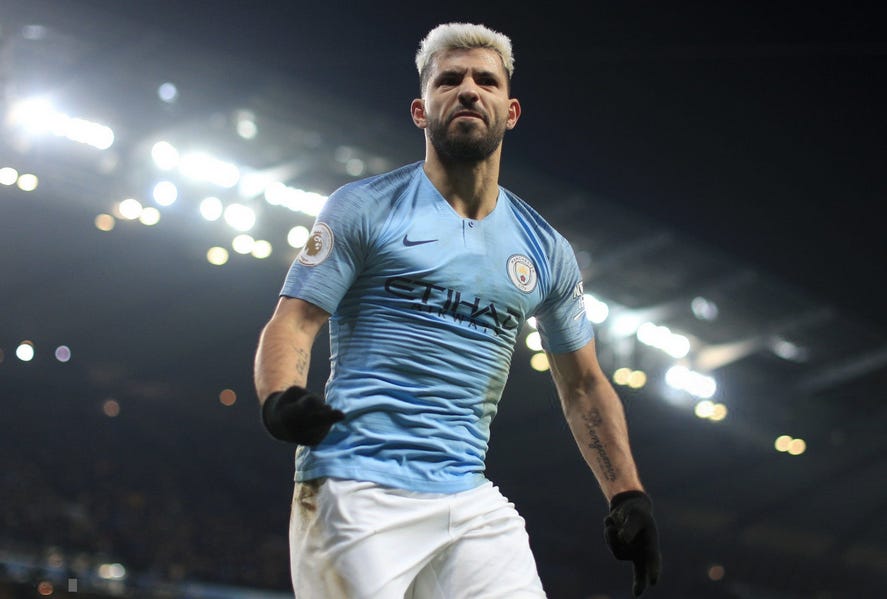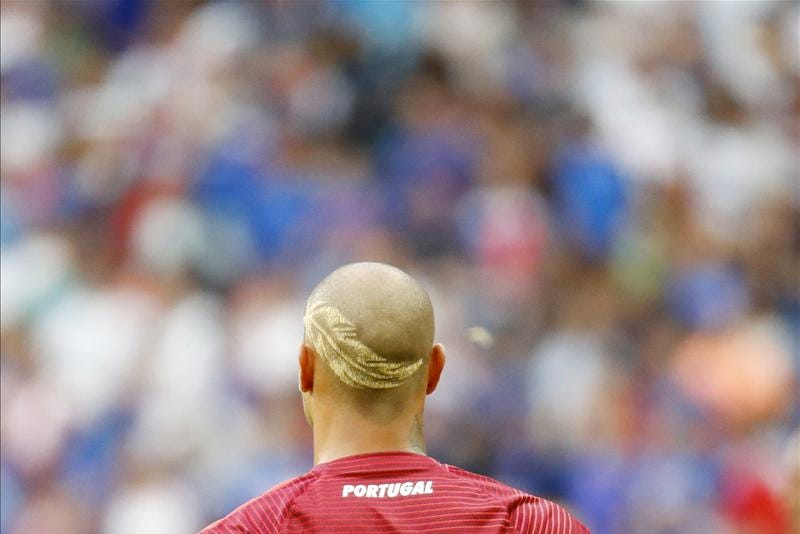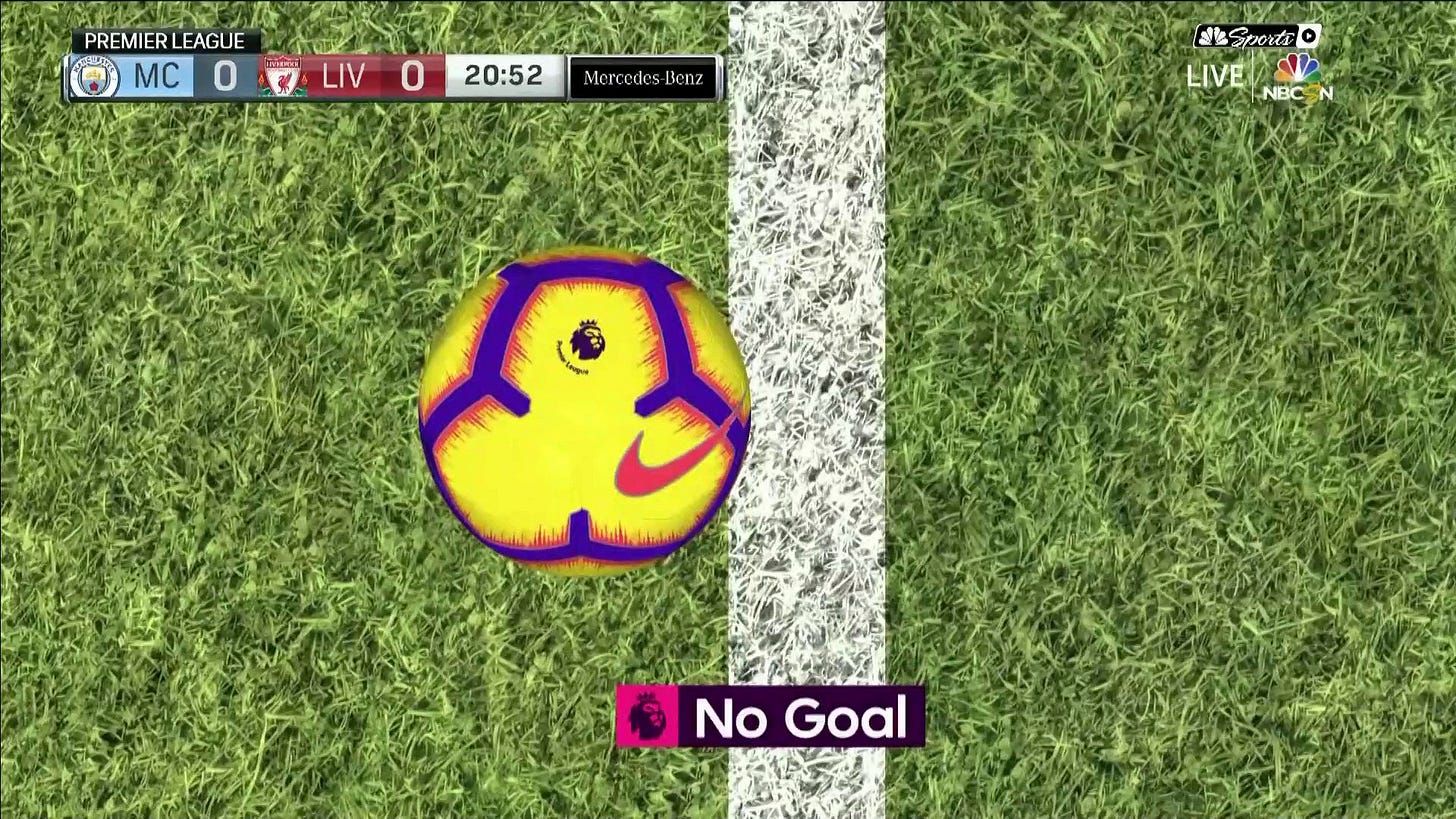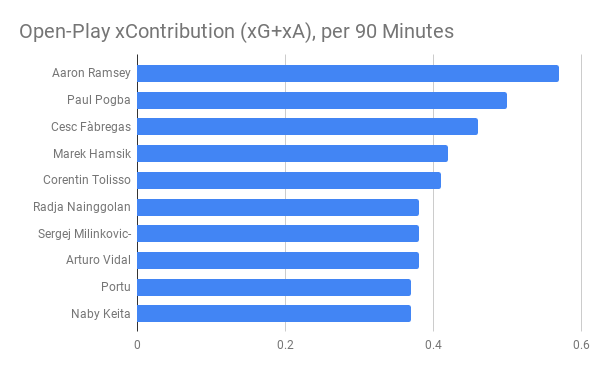Your European Soccer Crib Sheet, 1/4 Edition
Manchester City are back, Christian Pulisic is coming, and Aaron Ramsey might be leaving

After a week off, we’re back to our regularly scheduled Friday programming. (Read: we did this once, two weeks ago, and we’re about to do it again today.) For those of you that are new here or just plain forgot what we did on the last Friday that wasn’t between Christmas and New Years, the structure is this: Three interesting things happening across the world of soccer, ordered like such:
The first bullet will cater toward my mother and anyone else who’s a casual soccer fan. The second one will aim toward the average fan, someone who knows the table week in and week out and also has a handle on all of the major figures of the moment. And the third and final section will be for the uber-nerd who knows all about xG and has also watched every minute of every Ricardo Quaresma YouTube video.
Did I just quote myself? Yes. Did I just quote myself as an excuse to post another Quaresma-related piece of Internet content? Also, absolutely yes. Here’s the back of his head, in the unforgettable summer of 2016:

You’re welcome. OK -- on to the all of the things that are pretty-interesting-but-obviously-not-as-interesting-as-the-gleaming-golden-leaf-shaved-into-the-back-of-our-patron-saint’s-cranium.
That Whole “It’s a Game of Inches” Thing Isn’t a Cliche for City and Liverpool
The first one of these I sent out contained the following header: “Liverpool Are The Best Team in England, But They’re Not as Good As Manchester City.” Today, I arrive with a new, seemingly contradictory proclamation in headline-case: Liverpool Are the Best Team in England, And They’re as Good as Manchester City.
On Thursday, Liverpool and Manchester City played what wasn’t quite a title bout, but more like a one-sided elimination match. With Liverpool seven points ahead of City -- if you haven’t been following along with soccer since before the holidays, well boy do I have some news for you -- the Reds could’ve essentially knocked City out of title race with a win, which would’ve put them 10 points clear of their closest rivals with 17 games left. (Tottenham were ahead of City coming into the game, but I’m not ready to take them seriously yet. Why? Their goal differential is 14 back of both City and Liverpool, and they’ve allowed more shots than they’ve taken so far this season. That is not what you would call a recipe for sustainable success!) These were the pre-match stakes, in one specific probabilistic form:

Here’s what happened:
And here are the shots each team generated -- the bigger the square, the better the chance:


The teams pretty much played a 50/50 game — Liverpool had the slightly better chances, and City out-shot them 9 to 7 — but City won, well, because their shot that hit the post went in, and Liverpool’s shot that hit the post bounced back out toward the penalty spot and then, uh …
LOOK AT THIS SHIT!!!!!!!!

WHERE MY GOAL-LINE TECHNOLOGY TRUTHERS AT?
Allow me to channel my inner Derek here for a minute: The Premier League implemented goal-line technology back in 2013, and they’re using the same Hawk-Eye software you’ll see at most professional tennis events. Who owns Hawk-Eye? The Japanese multinational multimedia conglomerate corporation known as Sony. Who scored City’s winning goal on Thursday? Leroy Sane. WHICH PROFESSIONAL ATHLETE WHO TOOK PART IN THURSDAY’S GAME IS IN FACT SPONSORED BY SONY?
All right, back to reality (IF WE CAN EVEN CONFIDENTLY AFFIRM THAT WHAT WE ARE LIVING IS ACTUALLY REALITY). Is there some grand takeaway from this match? To me, it’s that Manchester City and Liverpool are about as evenly matched as two teams can be. On Thursday, City completed 466 passes, Liverpool 461. City completed 76 passes in the attacking third, Liverpool 76! City completed 11 passes in the penalty area, Liverpool 9. They have the exact same goal differential: plus-39. City’s xG numbers were way better than Liverpool’s for the first 10 or so games of the season, Liverpool’s have been much better than City’s over the most-recent 10 game stretch, and so they’ve met almost exactly at the top. You can use the xG a team creates and concedes in each match to determine their expected point total, and through 21 games, City is at 47.78, while Liverpool’s at 47.06. City had a little more fortune and a little more individual brilliance on Thursday, but Liverpool have had more of each of those things across the whole season, which is why they’ve still got a four-point lead (54 to 50).
When the two teams first met back in October, they drew 0-0 after City’s Riyad Mahrez missed a penalty in the 85th minute. If it went in, City would be one point behind Liverpool and have a two-goal lead on goal differential (which is the first tiebreaker). And if that wacky near-own goal on Thursday rolled a centimeter farther, Liverpool would currently be ahead by seven points, or perhaps even more. Instead, the various uncontrollable bounces, unstoppable volleys, and fingertip saves have all brought us here: Since 1981-82, every side to get to 52 points through 21 games has won the Premier League. They’re still the favorites, but the problem for Liverpool is that none of those teams had a challenger as close behind as City.
How Much Is Christian Pulisic Really Worth?
He’s worth whatever someone is willing to pay for him. Capitalism, baby!
I wanna quickly caution against comparing players based on the transfer fees attached to them. A transfer fee is as much a snapshot of circumstance as an indicator of talent: How desperate was the selling team to make a profit? (Lower fees!) How badly did the buying team want to fill a need? (Higher fees!) How young was the player when he moved? (Young? Higher fees! Old? Lower fees!) How many years were left on his contract? (More years? Higher fees! Fewer years? Lower fees!) That’s why, even when you adjust for inflation, the list of the most expensive transfers all time only looks vaguely similar to the most valuable players to ever play the game.
Let’s run through the specifics of the Pulisic move real quick:
Chelsea paid €64 /£58 million to Borussia Dortmund to acquire the 20-year-old American. That’s the 25th-most expensive transfer via the euro, and the 19th-most expensive transfer via the pound. Exchange rates, baby! (Imagine this guy teaching your econ class. That’s me.)
Pulisic is the third-most expensive Chelsea transfer of all time, behind goalkeeper Kepa and striker Alvaro Morata.
He’s — by far, by so far — the most expensive American player of all time, as the move more than tripled the price Wolfsburg paid for center back John Brooks last summer.
And one final, necessary, nuanced detail: Holy shit! A team that wants to win the Premier League and the Champions League just paid more than 70 million American dollars to acquire an American soccer player!
In the past, the thinking was that there was an inherent bias in the market against American players … because most American players were not very good. Now, it seems like Pulisic has flipped that on its head.
In a piece I wrote for Slate on Thursday, I ran through the context of the move, mainly from the perspective of the American Pulisic-watcher. I spoke to Omar Chaudhuri of the consultancy 21st Club, and based on their underlying plus-minus-esque rating sytem, he told me that Pulisic is the fourth-best under-21 player in the world, behind Bayer Leverkusen’s Kai Havertz, the kid who stole his spot at Dortmund in Jadon Sancho, and a little-known promising French youngster called Kylian Mbappe. As Mike Goodman wrote at The Athletic, Pulisic had similar production to Thomas Lemar and Leroy Sane when they were his age at Schalke and Monaco, respectively, and he moved for around the same price as the two of them did.
But even considering Pulisic’s potential and previously-sold players like him, £58 million seemed like a lot of money for a player who only had one year remaining on his contract and had already told Dortmund he would not be signing a new deal. Not only would that put Dortmund under the gun, but it meant that Chelsea would only be buying out a year and a half of potential Pulisic playing time, instead of, say, three or four years. So what pushed the price up that high? Two other wrinkles: 1) Chelsea probably paid a small premium to lock the deal up before other clubs seriously considered making bids. And 2) He’s American!
One thing you hear every transfer window is how Team X will make the money back from the deal from High-Profile Player Y through jersey sales. His popularity alone will pay back the transfer fee and maybe even pay his salary! That is … not true: Adidas/Nike/New Balance (lol)/etc. receive 85-90 percent of the money from a team’s jersey sales. However, there are a handful of players with the potential to make such a significant commercial impact that teams are willing to pay extra money to acquire them. (One example: Juventus’s move for Cristiano Ronaldo, before he was credibly accused of rape.) And by virtue of being the first American player with legitimate superstar potential, Pulisic falls into this group. Jake Cohen, a London-based sports lawyer with Premier League clients, has a better handle on high-level soccer finance than anyone I know, and here’s what he expects Pulisic’s immediate impact to be:

Eighteen-year-old me would badly need a haircut, and he also wouldn’t believe how accessible soccer is in the States now. More games are televised here than in the U.K. — seriously, it’s true! — while it seems like every city has a de-facto soccer bar, and there’s clearly a vibrant, sizable online community of American fans of the European game. (If not, this newsletter might not exist. Love all of you! (Also love all of you non-Americans!)) But, at least in theory, there’s still so much room for the Premier League (and all of its competitors) to grow into. Here’s Jake again:

All things considered: £58 million, somehow, might end up not even being all that much.
Bye, Aaron Ramsey. Hi, Aaron Ramsey.
Arsenal’s insistence on letting their best players run down their contracts continues apace! Last year, they went into the season with Alex Oxlade-Chamberlain, Alexis Sanchez, and Mesut Ozil — I’d argue, their three best players — all on the last year’s of their deals, and each one situation ended in varying forms of catastrophe. AOC — who could’ve predicted that two of the most important people in my life share the same trio of initials? — started the first few games of the season for the Gunners, was sold to Liverpool on the lat day of the summer transfer window, and went on to become a key contributor in their run to the Champions League final (before getting hurt). Sanchez was in and out of the lineup for the first half of the season and then sent to Manchester United in a swap deal for Henrikh Mkhitaryan, who’s not as good as Alexis Sanchez. And Ozil played it perfectly, re-signing to one of the biggest contracts in the league last January — except, now new manager Unai Emery now doesn’t consider him a full-time starter, the club seemingly wants him gone, and they can’t get rid of him … because they signed him to one of the biggest contracts in the league last January.
The latest Arsenal star to reach lame-duck status is the 28-year-old Aaron Ramsey, and the latest reports have the Welsh midfielder shipping off to Turin this summer:

So, what would Juve be getting and Arsenal losing if Ramsey swaps teams? A friend asked me the other day if Ramsey was good enough to start for a title-winning team, and he’s already proven that. The 2015-16 version of Arsenal was a title-winning team that didn’t win the title: They led the Premier League in both xG for and against; it’s just that the whole Leicester thing happened. (Arsenal have a much more crowded trophy cabinet in an oh-so-slightly alternate universe.) Ramsey played the most minutes of his career that season, and Arsenal were great, so there you go. But Ramsey’s always felt like a slightly awkward fit — to get the most out of him, you had to balance three or four other plates at once.
In 2015-16, Ozil put together what is probably best creative season the Premier League has ever seen, with 19 assists and 144 chances created — two figures that, at the time, hadn’t been matched by any other player in Europe’s big five leagues this decade. Per Statsbomb’s James Yorke, Ozil created the most chances for Sanchez that year. But in second was Ramsey, a midfielder, who theoretically, functioned farther back on the field than German no. 10.
However, Ramsey’s defining skill is his ability to make runs into the opposition box and break apart the defense: midfielders hate having to track other midfielders into the penalty area, and defenders just aren’t used to runs coming from Ramsey’s typical starting position. See for yourself:
In fact! According to data from Football Whispers, over the past two-and-a-half seasons, Ramsey leads all central midfielders in Europe’s top five leagues (with at least 2000 minutes played) in the xG+xA he creates from open play:

That’s an incredibly valuable skill! But it’s still dependent on others, and on a slightly wonky lineup construction. The rest of the team has to account, defensively, for the constant runs that pull him out of position and leave a gaping hole in the middle of the field. And since Ramsey isn’t the one moving the ball up the field, as you might expect from a central midfielder, there needs to be someone ahead of him who can do that job for him. In that role, he’s always had Ozil, who’s one of the best in the world at it:
But now Ozil is in and out of the lineup, and Ramsey has played all of his starter minutes this year in the attacking-midfield spot Ozil used to occupy. Earlier this week, I told you I wanted to see Paul Pogba pushed higher up the field; if he can create so much from deep, why not let him create even more from closer to the goal? But I’ve never felt that way about Ramsey. He just doesn’t have the same kind of tight-space dexterity as Pogba (because no really does), and so much of his effectiveness felt like it came directly from the awkward timing of his movement from midfield. Ramsey has been dynamite off the bench this season, and he leads Arsenal in assists with six, but despite despite playing in more advanced positions, his xG+xA production as a starter this season has basically halved.
So! Arsenal seem set to lose a constant, if confusing, source of production for nothing. Avert your eyes, Gunners fans: Football Whispers pegs Ramsey’s market value at £65 million. Meanwhile, Juventus would pick up yet another top player for nothing. It should be fascinating to see Ramsey in Serie A. Juventus barely get any goal-scoring or creative production from their current midfield — Miralem Pjanic leads them with 0.23 xG+xA per 90 — but go back and take a look at that list of progressive passers and dribblers. One thing you’ll notice: there’s not a single Juventus player on it. Ramsey can make all the runs he wants, but he’s still gonna need someone to get him the ball.
As I said last time, and now say every time: If you enjoyed this, please subscribe! And please pass on the word to anyone you know who might be interested. Call your boyfriend. Tell your girlfriend. Inform your mortal enemy. Everyone is welcome … unless you’re a fascist — in which case, get the hell outta here! Thanks, as always, to all you non-fascists for reading along.






